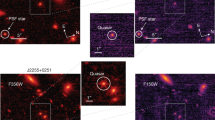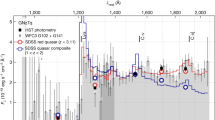Abstract
Quasars are the visible signatures of gas falling into the deep potential well of super-massive black holes in the centres of distant galaxies. It has been suggested1 that quasars are formed when two massive galaxies collide and merge, leading to the prediction that quasars should be found in the centres of regions of largest overdensity in the early Universe. In dark matter (DM)-dominated models of the early Universe, massive DM halos are predicted to attract the surrounding gas, which falls towards their centres. The neutral gas is not detectable in emission by itself, but gas falling into the ionizing cone of such a quasar will glow in the Lyman-α line of hydrogen, effectively imaging the DM halo2. Here we present a Lyα image of a DM halo at redshift z = 3, along with a two-dimensional spectrum of the gaseous halo. Our observations are best understood in the context of the standard model for DM haloes3; we infer a mass of (2 - 7) × 1012 solar masses (M⊙) for the halo.
This is a preview of subscription content, access via your institution
Access options
Subscribe to this journal
Receive 51 print issues and online access
$199.00 per year
only $3.90 per issue
Buy this article
- Purchase on Springer Link
- Instant access to full article PDF
Prices may be subject to local taxes which are calculated during checkout




Similar content being viewed by others
References
Carlberg, R. G. Quasar evolution via galaxy mergers. Astrophys. J. 350, 505–511 (1990)
Haiman, Z. & Rees, M. Extended Lyα emission around young quasars: a constraint on galaxy formation. Astrophys. J. 556, 87–92 (2001)
Navarro, J. F., Frenk, C. S. & White, S. D. M. A universal density profile from hierarchical clustering. Astrophys. J. 490, 493–508 (1997)
Barkana, R. & Loeb, A. Spectral signature of cosmological infall of gas around the first quasars. Nature 421, 341–343 (2003)
Fynbo, J. P. U., Thomsen, B. & Møller, P. Lyα emission from a Lyman limit absorber at z = 3.036. Astron. Astrophys. 353, 457–464 (2000)
Møller, P. Spectral PSF subtraction I: The SPSF look-up-table method. ESO Messenger 99, 31–33 (2000)
Møller, P., Warren, S. J., Fall, S. M., Jakobsen, P. & Fynbo, J. U. SPSF subtraction II: The extended Lyα emission of a radio quiet QSO. ESO Messenger 99, 33–35 (2000)
Bunker, A., Smith, J., Spinrad, H., Stern, D. & Warren, S. J. Illuminating protogalaxies? The discovery of extended Lyman-α emission around a QSO at z = 4.5. Astrophys. Space Sci. 284, 357–360 (2003)
Gould, A. & Weinberg, D. H. Imaging the forest of Lyman limit systems. Astrophys. J. 468, 462–468 (1996)
Barkana, R. A model for infall around virialized haloes. Mon. Not. R. Astron. Soc. 347, 59–66 (2004)
Lawrence, A. The relative frequency of broad-lined and narrow-lined active galactic nuclei – Implications for unified schemes. Mon. Not. R. Astron. Soc. 252, 586–592 (1991)
Elvis, M. A structure for quasars. Astrophys. J. 545, 63–76 (2000)
Blundell, K. M., Beasley, A. J. & Bicknell, G. V. A relativistic jet in the radio-quiet quasar PG 1407 + 263. Astrophys. J. 591, L103–L106 (2003)
Heckman, T. M., Lehnert, M. D., Miley, G. K. & van Breugel, W. Spectroscopy of spatially extended material around high-redshift radio-loud quasars. Astrophys. J. 381, 373–385 (1991)
Acknowledgements
This work was based on observations made with ESO telescopes at the Paranal Observatory.
Author information
Authors and Affiliations
Corresponding author
Ethics declarations
Competing interests
The authors declare that they have no competing financial interests.
Rights and permissions
About this article
Cite this article
Weidinger, M., Møller, P. & Fynbo, J. The Lyman-α glow of gas falling into the dark matter halo of a z = 3 galaxy. Nature 430, 999–1001 (2004). https://doi.org/10.1038/nature02793
Received:
Accepted:
Issue Date:
DOI: https://doi.org/10.1038/nature02793
Comments
By submitting a comment you agree to abide by our Terms and Community Guidelines. If you find something abusive or that does not comply with our terms or guidelines please flag it as inappropriate.



